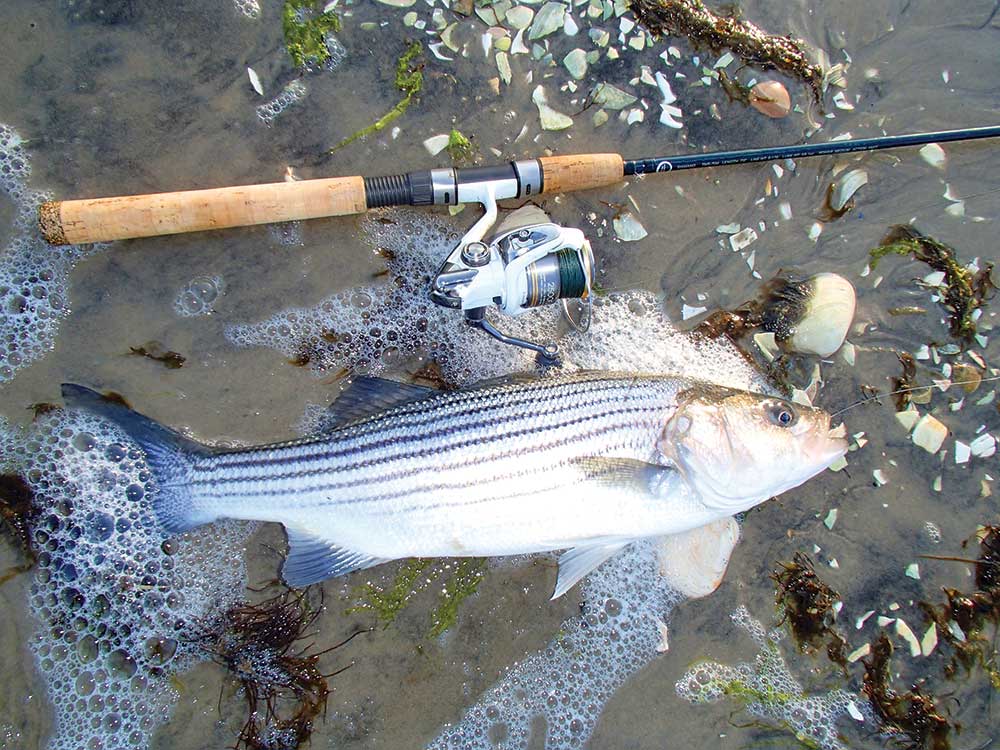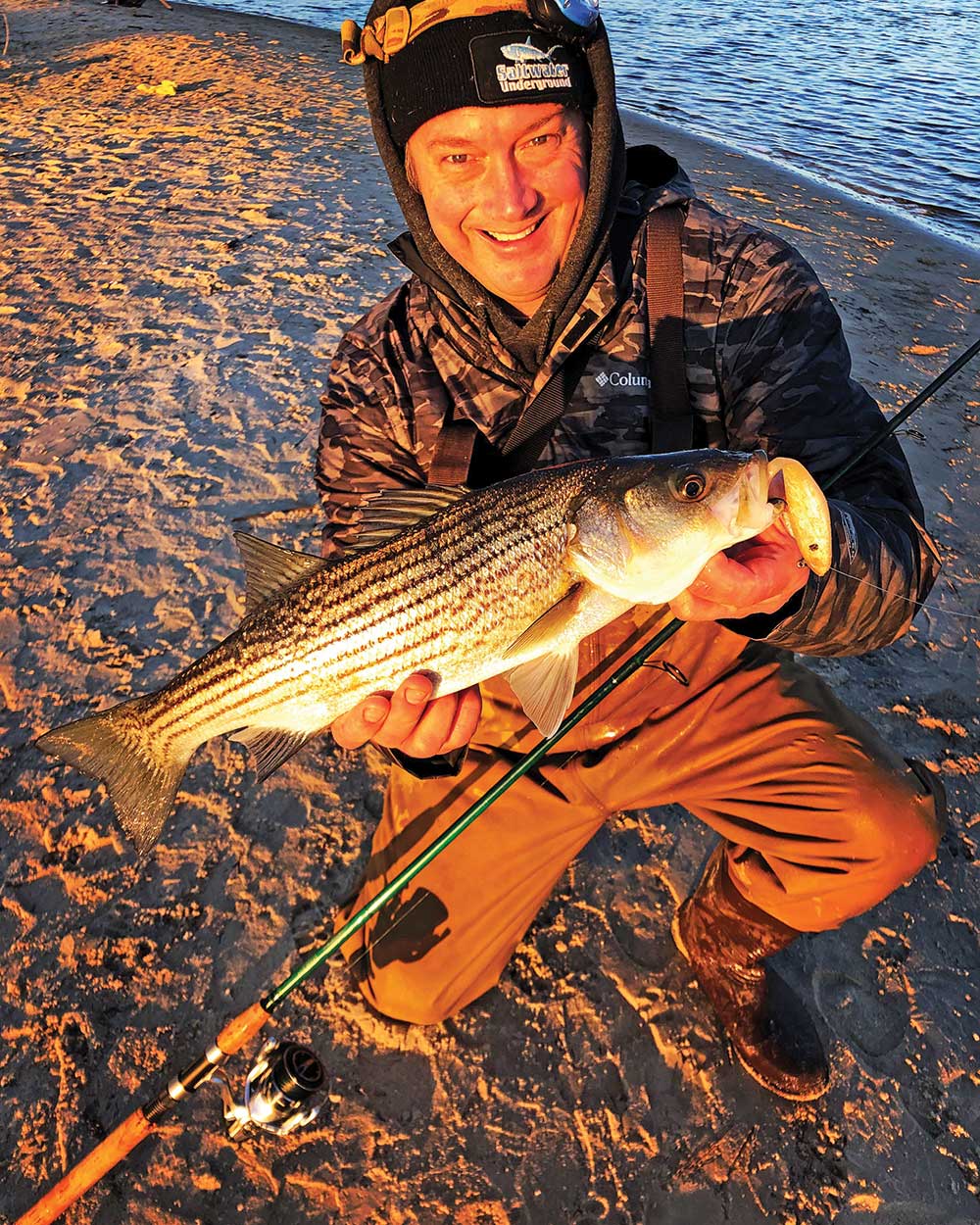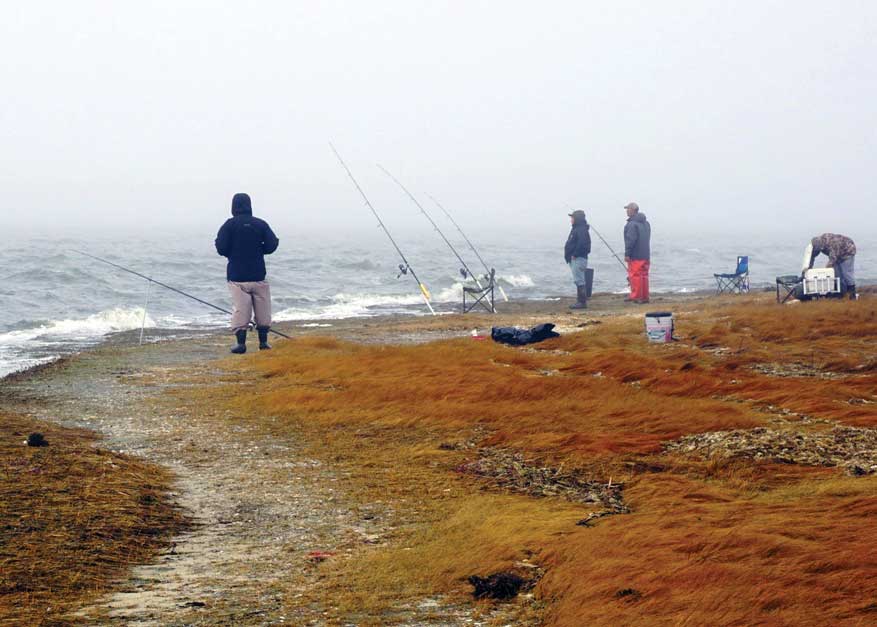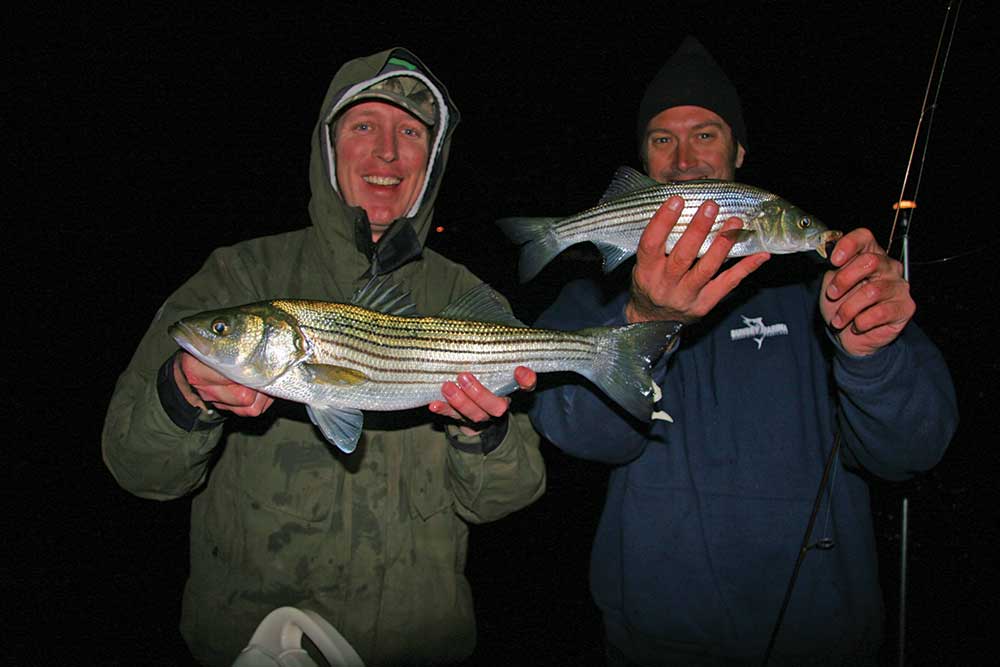
March 1 kicks off Jersey’s backwater striper season – target salt creeks and rivers for fast and furious schoolie action.
‘Twas a legendary night for me on March 6, 2019. A roaring, snowy nor’easter was barreling along the coast, low pressure dropping like it was tied to an anchor. Northeast winds kicked at 20 knots and were rising steadily.
Darkness had just fallen at 6 p.m. with an outgoing tide pushing out of the river. Despite the intimidating conditions, four of us landed and released 114 bass from 18 to 25 inches in a four-hour span. We weren’t fishing from a boat, nor in some kind of striper hatchery tank, but standing along the banks of a backwater river in New Jersey.
If water temps are right, and it looks like they may be right now, an early season bass brouhaha is available to March anglers hitting the state’s saltwater river systems during the opening days of the backwater striper season.
Raging Rivers
Up and down the coastline, salten river systems extend like fingers from the palm of the hand of the bay into the sod banks. In those fingers, stripers stage. Most bass in the area are holdover resident stripers that have weathered the winter months, and are generally categorized into mainly schoolie to shorty sizes of 18 to 26 inches, with the occasional migratory straggler over 28 inches.
Many back creeks are available to explore for striped bass in New Jersey as of the March 1 opener, but generally, notable and easily accessible areas include places of confluence such as at Graveling Point at the bottom of the Mullica River, the Toms River, Absecon Bay area creeks, Jeffer’s Landing, Shrewsbury River, along the Navesink River and throughout Great Egg River system. Try out the various river systems and see which produce for you.

March water temperatures in the back bays and rivers generally hover around the high 30s into the low to mid 40s at the start of the month, up to around 50 degrees by month’s end. The sweet spot temp is usually considered around 48 degrees when stripers will collectively open their mouths to feed in numbers rather than landing a straggler catch here and there. This year, water temps already look like they are going to be higher than normal, meaning a striper bite could be awaiting the day the calendar clicks to March 1.
In the early season, outgoing tides generally produce better as the shallower waters of the back bays warm up considerably faster as sunlight penetrates the thin waters and warms them, combined with the darkness of the muddy bottom to collect even more heat. Conversely, incoming tides usually usher in colder ocean water, which inherently drops temps and shuts down a bite. Outgoing tides can see water fluctuating sometimes by 5 to 7 degrees warmer, triggering bass to feed.
Bait Options
Baits can be attractive during the early season, most notably, sandworms, bloodworms and fresh clam bits. Certain rigs and baits offer a better advantage in various rivers depending on the environmental structure matched with the currents that run through areas. Where you find hard packed sedges, worms are naturally plentiful as the sedge banks harbor and direct funneling currents such as you’d find at Graveling Point. In these conditions, a fishfinder slide rig works best baited with whole sandworms or bloodworms, consisting of a fishfinder slide sinker clip, a 50-pound barrel swivel, 24-inch shot of 30-pound fluorocarbon leader and a size 2/0 baitholder hook. A 2- to 5-ounce pyramid or bank sinker is clipped onto the slide.

In more placid back rivers where tidal influence isn’t as strong and no notable sedge banks exist, but rather flat sandy bottom or gradually sloped riverbanks, hi-lo pill float rigs seem to pull more fish. You can buy the prepackaged kingfish rigs with the small fluorescent float above the hook or tie your own hi-lo rigs with 1/0 to 2/0 baitholder hooks, fixed with small pill floats above the hook, fastened with a 1- to 2-ounce bank sinker. Here, fresh small cut strips of clam cut into half inch slices or even Fishbites seem to garner more strikes.
Wait for the quick hits from schoolies and set the hook immediately. You can also opt to utilize sandworm and bloodworm bits on the hooks as well, threading them onto the shank and leaving a little end hanging off the barb for bass to nibble upon. Interestingly, I’ve found that stripers will bite with some ferocity into the night hours usually an hour after sunset for the next two hours.
Generally speaking, early season bass in March are on a bait bite as they are slow to feed and do not want to expend much energy chasing down a meal. That said, there are also times when artificials can spark a strike. Last year on March 12, with 44-degree water temps, small white 3-inch Storm and Tsunami shads as well as small Yo-Zuri Mag Darters accounted for dozens of bass from 20 to 26 inches for a week straight of morning sessions, though only when a combination of factors combined – a sunny morning, an outgoing tide and a slow presentation. As per my fishing logs, the chew would shut down right around 8:30 a.m. every day.
There’s going to be a time and a place to target big breeder linesiders oceanside in May and June. Right now, it’s all about knocking the rust off your gear, breaking out the light tackle, and playing a fun game of catch and release with shorty bass in the myriad salt creeks and river systems along the coastline.
Take advantage of the opportune fishery opening up to us in the Garden State as of March 1. For many, it’ll put the first smiles of the fishing year on your face.

| RULES & REGS AS OF 2021 |
|---|
|
New Jersey’s back bay striper fishery opens on March 1; the regulation throughout New Jersey is one striped bass at 28 to less than 38 inches. Prior to March 1, there is no targeting of striped bass in the back bays and rivers of New Jersey. On the Delaware River and its tributaries between the Calhoun St. Bridge in Trenton and Salem River and tributaries, striped bass fishing is prohibited between April 1 and May 31. Keep in mind that as of 2021, circle hooks are required when anglers are using natural baits like worms or clams when targeting striped bass. Anglers in New Jersey may also register for the New Jersey Striped Bass Bonus Program (SBBP) which allows an angler in possession of an SBBP tag to harvest one striped bass of 24 to less than 28 inches in length to which that tag is affixed. The SBBP season opens May 15 and runs through until the end of the year (or until all tags are distributed). Go to www.state.nj.us/dep/fgw/bonusbas.htm. |




